EHGES ILE - Epidemiology Report: Antibiotic Resistance in Meat
VerifiedAdded on 2022/10/19
|13
|5874
|110
Report
AI Summary
This report, focusing on the epidemiology of antibiotic resistance, investigates the association between meat products, animal husbandry practices, and the use of sub-therapeutic antibiotics for growth stimulation, and the development of antibiotic-resistant microbes. The executive summary highlights that the misuse of antibiotics in animals is a significant public health issue, leading to increased antimicrobial resistance (AMR) and associated risks, including increased morbidity, mortality, and healthcare costs. The report explores the role of antibiotic usage in animal agriculture, particularly in the US, and its impact on the development of antibiotic-resistant bacteria, which can then be transmitted to humans through meat consumption. It emphasizes the need for research into new antimicrobials and comprehensive education plans. The report further discusses the impact of meat consumption as a risk factor for AMR in humans, the effect of hygiene and sanitation, and vaccination on reducing the spread of resistant bacteria. The conclusion of the study provides a foundation to the stakeholders including governments to develop better ways to curbing the use of antibiotics in animals, especially in feed and promoting the growth of these animals, mainly livestock. The report also includes an annotated bibliography of relevant research articles.
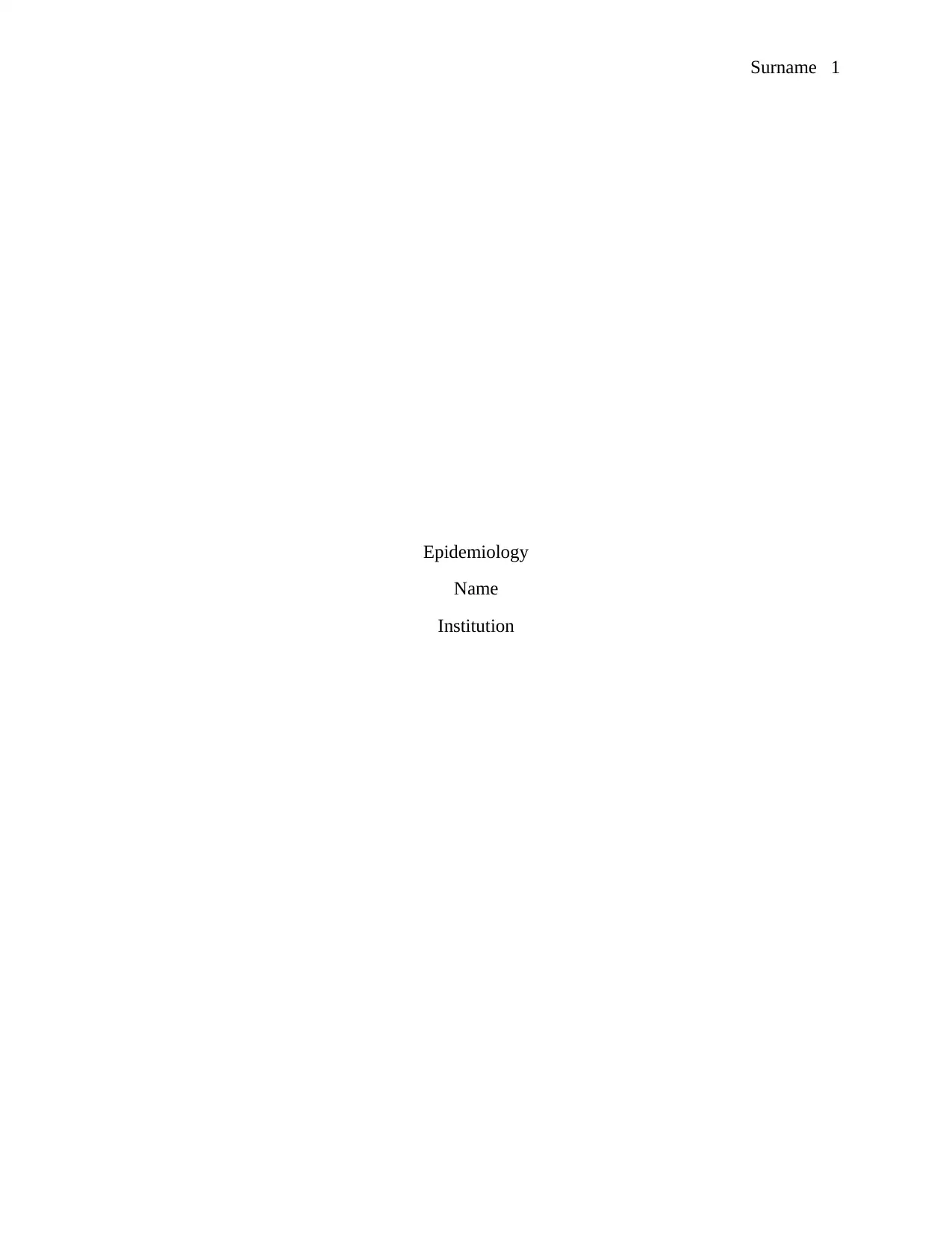
Surname 1
Epidemiology
Name
Institution
Epidemiology
Name
Institution
Paraphrase This Document
Need a fresh take? Get an instant paraphrase of this document with our AI Paraphraser
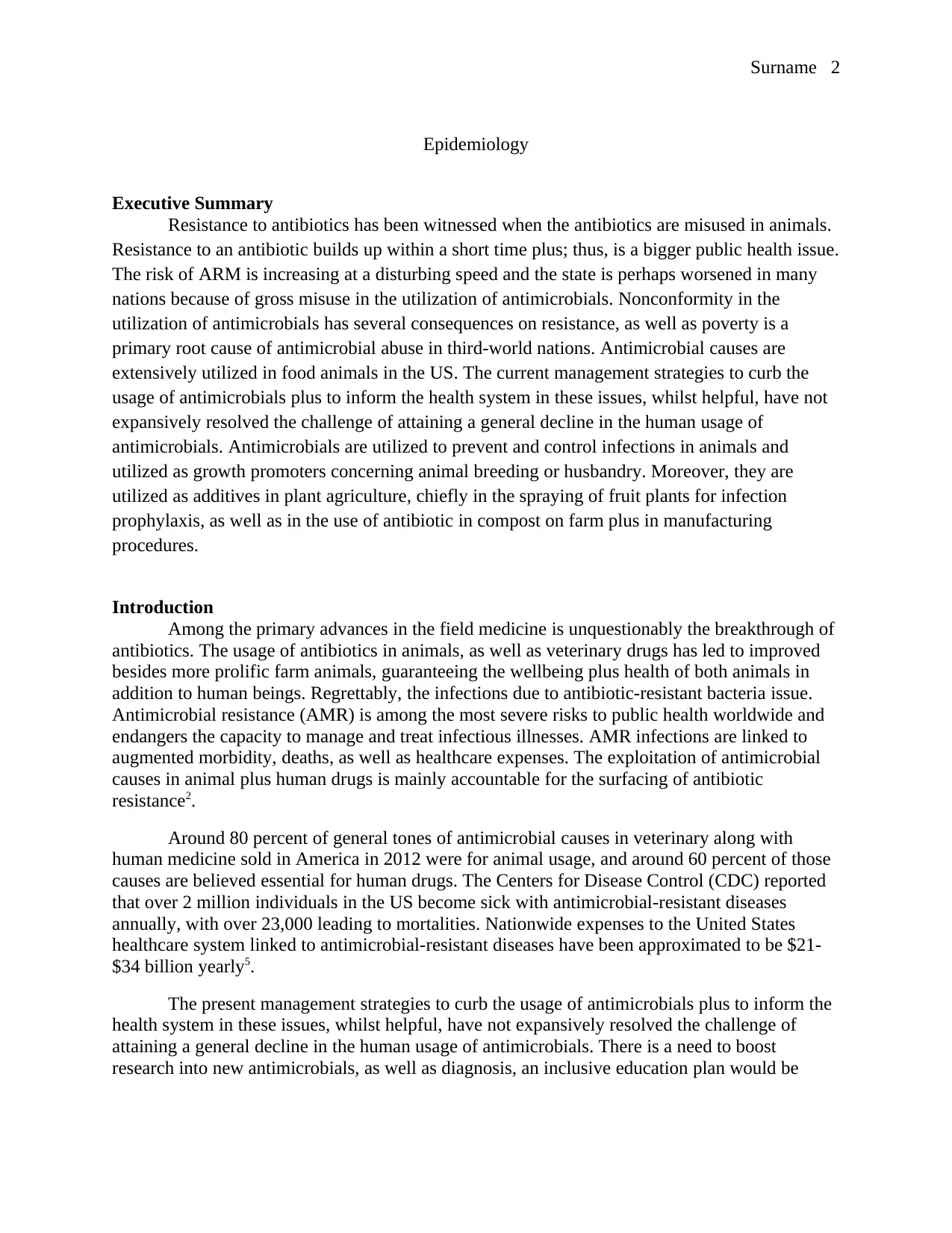
Surname 2
Epidemiology
Executive Summary
Resistance to antibiotics has been witnessed when the antibiotics are misused in animals.
Resistance to an antibiotic builds up within a short time plus; thus, is a bigger public health issue.
The risk of ARM is increasing at a disturbing speed and the state is perhaps worsened in many
nations because of gross misuse in the utilization of antimicrobials. Nonconformity in the
utilization of antimicrobials has several consequences on resistance, as well as poverty is a
primary root cause of antimicrobial abuse in third-world nations. Antimicrobial causes are
extensively utilized in food animals in the US. The current management strategies to curb the
usage of antimicrobials plus to inform the health system in these issues, whilst helpful, have not
expansively resolved the challenge of attaining a general decline in the human usage of
antimicrobials. Antimicrobials are utilized to prevent and control infections in animals and
utilized as growth promoters concerning animal breeding or husbandry. Moreover, they are
utilized as additives in plant agriculture, chiefly in the spraying of fruit plants for infection
prophylaxis, as well as in the use of antibiotic in compost on farm plus in manufacturing
procedures.
Introduction
Among the primary advances in the field medicine is unquestionably the breakthrough of
antibiotics. The usage of antibiotics in animals, as well as veterinary drugs has led to improved
besides more prolific farm animals, guaranteeing the wellbeing plus health of both animals in
addition to human beings. Regrettably, the infections due to antibiotic-resistant bacteria issue.
Antimicrobial resistance (AMR) is among the most severe risks to public health worldwide and
endangers the capacity to manage and treat infectious illnesses. AMR infections are linked to
augmented morbidity, deaths, as well as healthcare expenses. The exploitation of antimicrobial
causes in animal plus human drugs is mainly accountable for the surfacing of antibiotic
resistance2.
Around 80 percent of general tones of antimicrobial causes in veterinary along with
human medicine sold in America in 2012 were for animal usage, and around 60 percent of those
causes are believed essential for human drugs. The Centers for Disease Control (CDC) reported
that over 2 million individuals in the US become sick with antimicrobial-resistant diseases
annually, with over 23,000 leading to mortalities. Nationwide expenses to the United States
healthcare system linked to antimicrobial-resistant diseases have been approximated to be $21-
$34 billion yearly5.
The present management strategies to curb the usage of antimicrobials plus to inform the
health system in these issues, whilst helpful, have not expansively resolved the challenge of
attaining a general decline in the human usage of antimicrobials. There is a need to boost
research into new antimicrobials, as well as diagnosis, an inclusive education plan would be
Epidemiology
Executive Summary
Resistance to antibiotics has been witnessed when the antibiotics are misused in animals.
Resistance to an antibiotic builds up within a short time plus; thus, is a bigger public health issue.
The risk of ARM is increasing at a disturbing speed and the state is perhaps worsened in many
nations because of gross misuse in the utilization of antimicrobials. Nonconformity in the
utilization of antimicrobials has several consequences on resistance, as well as poverty is a
primary root cause of antimicrobial abuse in third-world nations. Antimicrobial causes are
extensively utilized in food animals in the US. The current management strategies to curb the
usage of antimicrobials plus to inform the health system in these issues, whilst helpful, have not
expansively resolved the challenge of attaining a general decline in the human usage of
antimicrobials. Antimicrobials are utilized to prevent and control infections in animals and
utilized as growth promoters concerning animal breeding or husbandry. Moreover, they are
utilized as additives in plant agriculture, chiefly in the spraying of fruit plants for infection
prophylaxis, as well as in the use of antibiotic in compost on farm plus in manufacturing
procedures.
Introduction
Among the primary advances in the field medicine is unquestionably the breakthrough of
antibiotics. The usage of antibiotics in animals, as well as veterinary drugs has led to improved
besides more prolific farm animals, guaranteeing the wellbeing plus health of both animals in
addition to human beings. Regrettably, the infections due to antibiotic-resistant bacteria issue.
Antimicrobial resistance (AMR) is among the most severe risks to public health worldwide and
endangers the capacity to manage and treat infectious illnesses. AMR infections are linked to
augmented morbidity, deaths, as well as healthcare expenses. The exploitation of antimicrobial
causes in animal plus human drugs is mainly accountable for the surfacing of antibiotic
resistance2.
Around 80 percent of general tones of antimicrobial causes in veterinary along with
human medicine sold in America in 2012 were for animal usage, and around 60 percent of those
causes are believed essential for human drugs. The Centers for Disease Control (CDC) reported
that over 2 million individuals in the US become sick with antimicrobial-resistant diseases
annually, with over 23,000 leading to mortalities. Nationwide expenses to the United States
healthcare system linked to antimicrobial-resistant diseases have been approximated to be $21-
$34 billion yearly5.
The present management strategies to curb the usage of antimicrobials plus to inform the
health system in these issues, whilst helpful, have not expansively resolved the challenge of
attaining a general decline in the human usage of antimicrobials. There is a need to boost
research into new antimicrobials, as well as diagnosis, an inclusive education plan would be
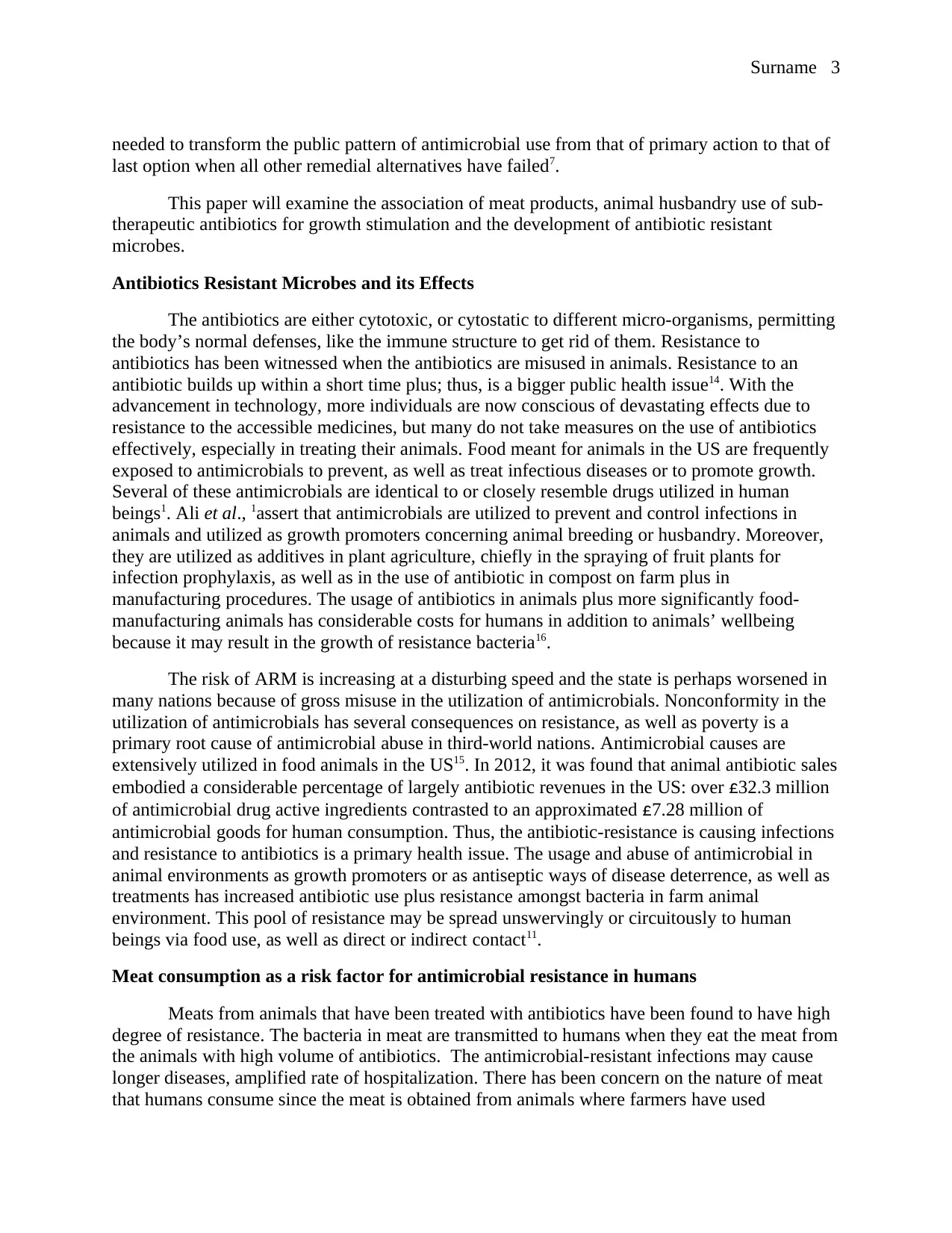
Surname 3
needed to transform the public pattern of antimicrobial use from that of primary action to that of
last option when all other remedial alternatives have failed7.
This paper will examine the association of meat products, animal husbandry use of sub-
therapeutic antibiotics for growth stimulation and the development of antibiotic resistant
microbes.
Antibiotics Resistant Microbes and its Effects
The antibiotics are either cytotoxic, or cytostatic to different micro-organisms, permitting
the body’s normal defenses, like the immune structure to get rid of them. Resistance to
antibiotics has been witnessed when the antibiotics are misused in animals. Resistance to an
antibiotic builds up within a short time plus; thus, is a bigger public health issue14. With the
advancement in technology, more individuals are now conscious of devastating effects due to
resistance to the accessible medicines, but many do not take measures on the use of antibiotics
effectively, especially in treating their animals. Food meant for animals in the US are frequently
exposed to antimicrobials to prevent, as well as treat infectious diseases or to promote growth.
Several of these antimicrobials are identical to or closely resemble drugs utilized in human
beings1. Ali et al., 1assert that antimicrobials are utilized to prevent and control infections in
animals and utilized as growth promoters concerning animal breeding or husbandry. Moreover,
they are utilized as additives in plant agriculture, chiefly in the spraying of fruit plants for
infection prophylaxis, as well as in the use of antibiotic in compost on farm plus in
manufacturing procedures. The usage of antibiotics in animals plus more significantly food-
manufacturing animals has considerable costs for humans in addition to animals’ wellbeing
because it may result in the growth of resistance bacteria16.
The risk of ARM is increasing at a disturbing speed and the state is perhaps worsened in
many nations because of gross misuse in the utilization of antimicrobials. Nonconformity in the
utilization of antimicrobials has several consequences on resistance, as well as poverty is a
primary root cause of antimicrobial abuse in third-world nations. Antimicrobial causes are
extensively utilized in food animals in the US15. In 2012, it was found that animal antibiotic sales
embodied a considerable percentage of largely antibiotic revenues in the US: over £32.3 million
of antimicrobial drug active ingredients contrasted to an approximated £7.28 million of
antimicrobial goods for human consumption. Thus, the antibiotic-resistance is causing infections
and resistance to antibiotics is a primary health issue. The usage and abuse of antimicrobial in
animal environments as growth promoters or as antiseptic ways of disease deterrence, as well as
treatments has increased antibiotic use plus resistance amongst bacteria in farm animal
environment. This pool of resistance may be spread unswervingly or circuitously to human
beings via food use, as well as direct or indirect contact11.
Meat consumption as a risk factor for antimicrobial resistance in humans
Meats from animals that have been treated with antibiotics have been found to have high
degree of resistance. The bacteria in meat are transmitted to humans when they eat the meat from
the animals with high volume of antibiotics. The antimicrobial-resistant infections may cause
longer diseases, amplified rate of hospitalization. There has been concern on the nature of meat
that humans consume since the meat is obtained from animals where farmers have used
needed to transform the public pattern of antimicrobial use from that of primary action to that of
last option when all other remedial alternatives have failed7.
This paper will examine the association of meat products, animal husbandry use of sub-
therapeutic antibiotics for growth stimulation and the development of antibiotic resistant
microbes.
Antibiotics Resistant Microbes and its Effects
The antibiotics are either cytotoxic, or cytostatic to different micro-organisms, permitting
the body’s normal defenses, like the immune structure to get rid of them. Resistance to
antibiotics has been witnessed when the antibiotics are misused in animals. Resistance to an
antibiotic builds up within a short time plus; thus, is a bigger public health issue14. With the
advancement in technology, more individuals are now conscious of devastating effects due to
resistance to the accessible medicines, but many do not take measures on the use of antibiotics
effectively, especially in treating their animals. Food meant for animals in the US are frequently
exposed to antimicrobials to prevent, as well as treat infectious diseases or to promote growth.
Several of these antimicrobials are identical to or closely resemble drugs utilized in human
beings1. Ali et al., 1assert that antimicrobials are utilized to prevent and control infections in
animals and utilized as growth promoters concerning animal breeding or husbandry. Moreover,
they are utilized as additives in plant agriculture, chiefly in the spraying of fruit plants for
infection prophylaxis, as well as in the use of antibiotic in compost on farm plus in
manufacturing procedures. The usage of antibiotics in animals plus more significantly food-
manufacturing animals has considerable costs for humans in addition to animals’ wellbeing
because it may result in the growth of resistance bacteria16.
The risk of ARM is increasing at a disturbing speed and the state is perhaps worsened in
many nations because of gross misuse in the utilization of antimicrobials. Nonconformity in the
utilization of antimicrobials has several consequences on resistance, as well as poverty is a
primary root cause of antimicrobial abuse in third-world nations. Antimicrobial causes are
extensively utilized in food animals in the US15. In 2012, it was found that animal antibiotic sales
embodied a considerable percentage of largely antibiotic revenues in the US: over £32.3 million
of antimicrobial drug active ingredients contrasted to an approximated £7.28 million of
antimicrobial goods for human consumption. Thus, the antibiotic-resistance is causing infections
and resistance to antibiotics is a primary health issue. The usage and abuse of antimicrobial in
animal environments as growth promoters or as antiseptic ways of disease deterrence, as well as
treatments has increased antibiotic use plus resistance amongst bacteria in farm animal
environment. This pool of resistance may be spread unswervingly or circuitously to human
beings via food use, as well as direct or indirect contact11.
Meat consumption as a risk factor for antimicrobial resistance in humans
Meats from animals that have been treated with antibiotics have been found to have high
degree of resistance. The bacteria in meat are transmitted to humans when they eat the meat from
the animals with high volume of antibiotics. The antimicrobial-resistant infections may cause
longer diseases, amplified rate of hospitalization. There has been concern on the nature of meat
that humans consume since the meat is obtained from animals where farmers have used
⊘ This is a preview!⊘
Do you want full access?
Subscribe today to unlock all pages.

Trusted by 1+ million students worldwide
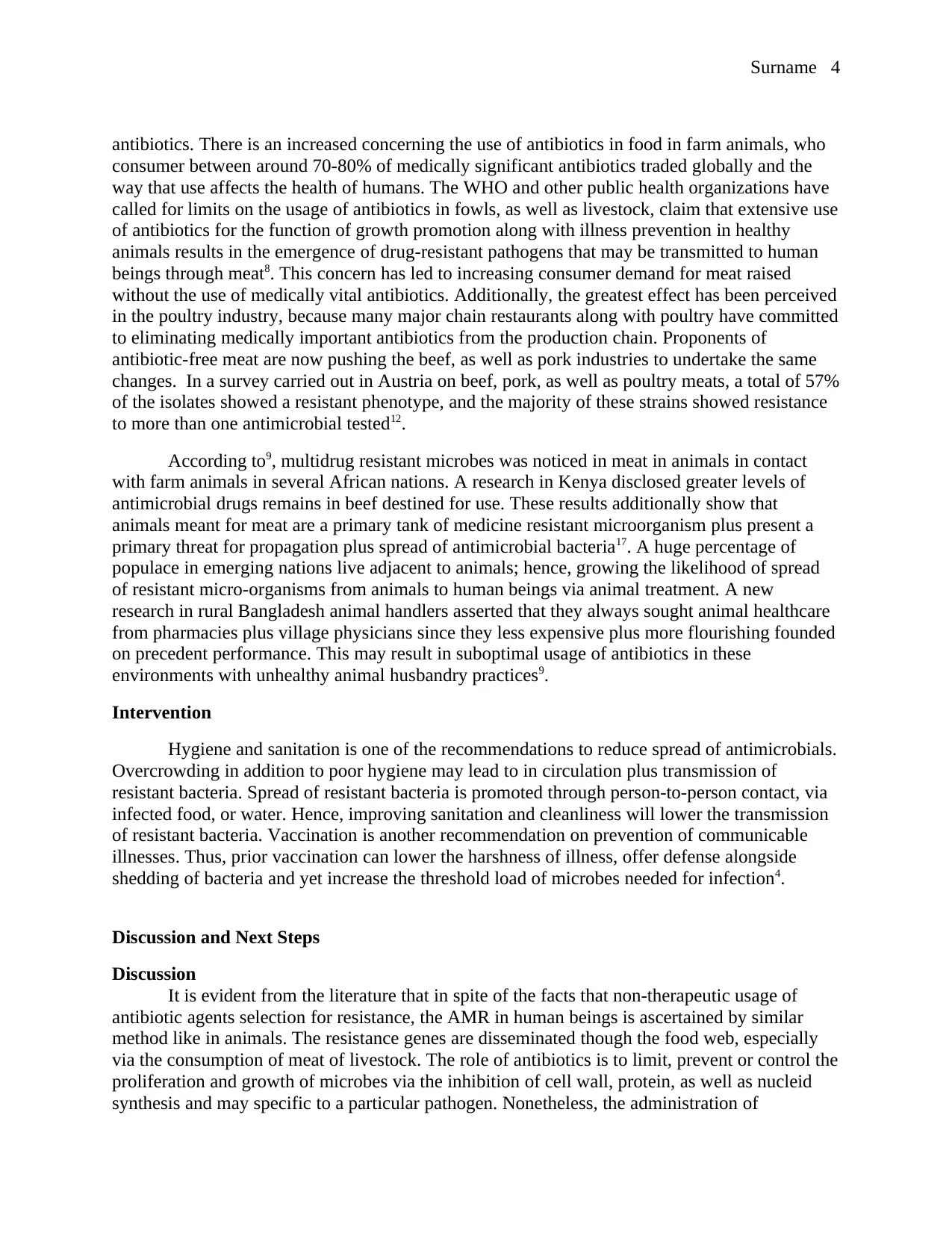
Surname 4
antibiotics. There is an increased concerning the use of antibiotics in food in farm animals, who
consumer between around 70-80% of medically significant antibiotics traded globally and the
way that use affects the health of humans. The WHO and other public health organizations have
called for limits on the usage of antibiotics in fowls, as well as livestock, claim that extensive use
of antibiotics for the function of growth promotion along with illness prevention in healthy
animals results in the emergence of drug-resistant pathogens that may be transmitted to human
beings through meat8. This concern has led to increasing consumer demand for meat raised
without the use of medically vital antibiotics. Additionally, the greatest effect has been perceived
in the poultry industry, because many major chain restaurants along with poultry have committed
to eliminating medically important antibiotics from the production chain. Proponents of
antibiotic-free meat are now pushing the beef, as well as pork industries to undertake the same
changes. In a survey carried out in Austria on beef, pork, as well as poultry meats, a total of 57%
of the isolates showed a resistant phenotype, and the majority of these strains showed resistance
to more than one antimicrobial tested12.
According to9, multidrug resistant microbes was noticed in meat in animals in contact
with farm animals in several African nations. A research in Kenya disclosed greater levels of
antimicrobial drugs remains in beef destined for use. These results additionally show that
animals meant for meat are a primary tank of medicine resistant microorganism plus present a
primary threat for propagation plus spread of antimicrobial bacteria17. A huge percentage of
populace in emerging nations live adjacent to animals; hence, growing the likelihood of spread
of resistant micro-organisms from animals to human beings via animal treatment. A new
research in rural Bangladesh animal handlers asserted that they always sought animal healthcare
from pharmacies plus village physicians since they less expensive plus more flourishing founded
on precedent performance. This may result in suboptimal usage of antibiotics in these
environments with unhealthy animal husbandry practices9.
Intervention
Hygiene and sanitation is one of the recommendations to reduce spread of antimicrobials.
Overcrowding in addition to poor hygiene may lead to in circulation plus transmission of
resistant bacteria. Spread of resistant bacteria is promoted through person-to-person contact, via
infected food, or water. Hence, improving sanitation and cleanliness will lower the transmission
of resistant bacteria. Vaccination is another recommendation on prevention of communicable
illnesses. Thus, prior vaccination can lower the harshness of illness, offer defense alongside
shedding of bacteria and yet increase the threshold load of microbes needed for infection4.
Discussion and Next Steps
Discussion
It is evident from the literature that in spite of the facts that non-therapeutic usage of
antibiotic agents selection for resistance, the AMR in human beings is ascertained by similar
method like in animals. The resistance genes are disseminated though the food web, especially
via the consumption of meat of livestock. The role of antibiotics is to limit, prevent or control the
proliferation and growth of microbes via the inhibition of cell wall, protein, as well as nucleid
synthesis and may specific to a particular pathogen. Nonetheless, the administration of
antibiotics. There is an increased concerning the use of antibiotics in food in farm animals, who
consumer between around 70-80% of medically significant antibiotics traded globally and the
way that use affects the health of humans. The WHO and other public health organizations have
called for limits on the usage of antibiotics in fowls, as well as livestock, claim that extensive use
of antibiotics for the function of growth promotion along with illness prevention in healthy
animals results in the emergence of drug-resistant pathogens that may be transmitted to human
beings through meat8. This concern has led to increasing consumer demand for meat raised
without the use of medically vital antibiotics. Additionally, the greatest effect has been perceived
in the poultry industry, because many major chain restaurants along with poultry have committed
to eliminating medically important antibiotics from the production chain. Proponents of
antibiotic-free meat are now pushing the beef, as well as pork industries to undertake the same
changes. In a survey carried out in Austria on beef, pork, as well as poultry meats, a total of 57%
of the isolates showed a resistant phenotype, and the majority of these strains showed resistance
to more than one antimicrobial tested12.
According to9, multidrug resistant microbes was noticed in meat in animals in contact
with farm animals in several African nations. A research in Kenya disclosed greater levels of
antimicrobial drugs remains in beef destined for use. These results additionally show that
animals meant for meat are a primary tank of medicine resistant microorganism plus present a
primary threat for propagation plus spread of antimicrobial bacteria17. A huge percentage of
populace in emerging nations live adjacent to animals; hence, growing the likelihood of spread
of resistant micro-organisms from animals to human beings via animal treatment. A new
research in rural Bangladesh animal handlers asserted that they always sought animal healthcare
from pharmacies plus village physicians since they less expensive plus more flourishing founded
on precedent performance. This may result in suboptimal usage of antibiotics in these
environments with unhealthy animal husbandry practices9.
Intervention
Hygiene and sanitation is one of the recommendations to reduce spread of antimicrobials.
Overcrowding in addition to poor hygiene may lead to in circulation plus transmission of
resistant bacteria. Spread of resistant bacteria is promoted through person-to-person contact, via
infected food, or water. Hence, improving sanitation and cleanliness will lower the transmission
of resistant bacteria. Vaccination is another recommendation on prevention of communicable
illnesses. Thus, prior vaccination can lower the harshness of illness, offer defense alongside
shedding of bacteria and yet increase the threshold load of microbes needed for infection4.
Discussion and Next Steps
Discussion
It is evident from the literature that in spite of the facts that non-therapeutic usage of
antibiotic agents selection for resistance, the AMR in human beings is ascertained by similar
method like in animals. The resistance genes are disseminated though the food web, especially
via the consumption of meat of livestock. The role of antibiotics is to limit, prevent or control the
proliferation and growth of microbes via the inhibition of cell wall, protein, as well as nucleid
synthesis and may specific to a particular pathogen. Nonetheless, the administration of
Paraphrase This Document
Need a fresh take? Get an instant paraphrase of this document with our AI Paraphraser
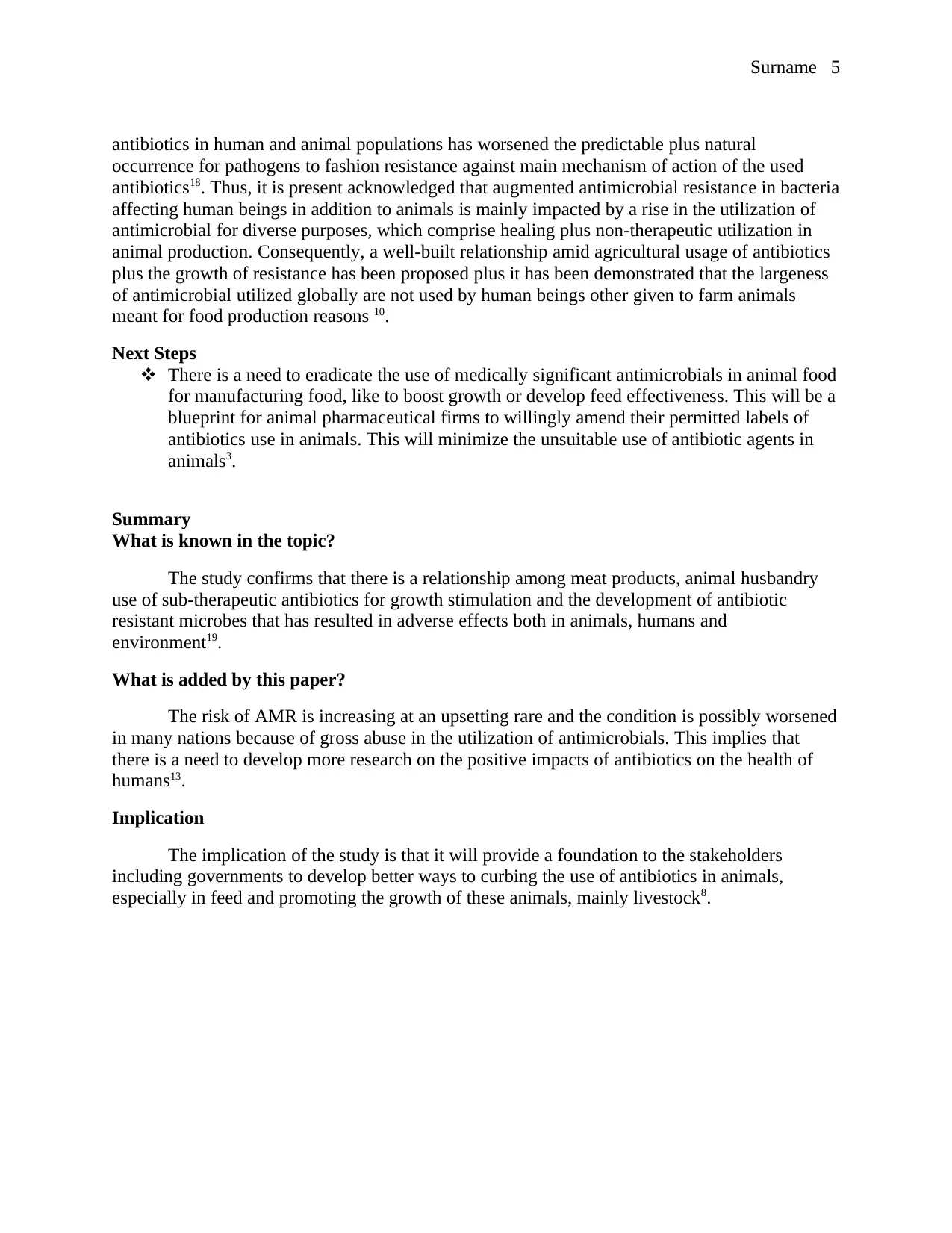
Surname 5
antibiotics in human and animal populations has worsened the predictable plus natural
occurrence for pathogens to fashion resistance against main mechanism of action of the used
antibiotics18. Thus, it is present acknowledged that augmented antimicrobial resistance in bacteria
affecting human beings in addition to animals is mainly impacted by a rise in the utilization of
antimicrobial for diverse purposes, which comprise healing plus non-therapeutic utilization in
animal production. Consequently, a well-built relationship amid agricultural usage of antibiotics
plus the growth of resistance has been proposed plus it has been demonstrated that the largeness
of antimicrobial utilized globally are not used by human beings other given to farm animals
meant for food production reasons 10.
Next Steps
There is a need to eradicate the use of medically significant antimicrobials in animal food
for manufacturing food, like to boost growth or develop feed effectiveness. This will be a
blueprint for animal pharmaceutical firms to willingly amend their permitted labels of
antibiotics use in animals. This will minimize the unsuitable use of antibiotic agents in
animals3.
Summary
What is known in the topic?
The study confirms that there is a relationship among meat products, animal husbandry
use of sub-therapeutic antibiotics for growth stimulation and the development of antibiotic
resistant microbes that has resulted in adverse effects both in animals, humans and
environment19.
What is added by this paper?
The risk of AMR is increasing at an upsetting rare and the condition is possibly worsened
in many nations because of gross abuse in the utilization of antimicrobials. This implies that
there is a need to develop more research on the positive impacts of antibiotics on the health of
humans13.
Implication
The implication of the study is that it will provide a foundation to the stakeholders
including governments to develop better ways to curbing the use of antibiotics in animals,
especially in feed and promoting the growth of these animals, mainly livestock8.
antibiotics in human and animal populations has worsened the predictable plus natural
occurrence for pathogens to fashion resistance against main mechanism of action of the used
antibiotics18. Thus, it is present acknowledged that augmented antimicrobial resistance in bacteria
affecting human beings in addition to animals is mainly impacted by a rise in the utilization of
antimicrobial for diverse purposes, which comprise healing plus non-therapeutic utilization in
animal production. Consequently, a well-built relationship amid agricultural usage of antibiotics
plus the growth of resistance has been proposed plus it has been demonstrated that the largeness
of antimicrobial utilized globally are not used by human beings other given to farm animals
meant for food production reasons 10.
Next Steps
There is a need to eradicate the use of medically significant antimicrobials in animal food
for manufacturing food, like to boost growth or develop feed effectiveness. This will be a
blueprint for animal pharmaceutical firms to willingly amend their permitted labels of
antibiotics use in animals. This will minimize the unsuitable use of antibiotic agents in
animals3.
Summary
What is known in the topic?
The study confirms that there is a relationship among meat products, animal husbandry
use of sub-therapeutic antibiotics for growth stimulation and the development of antibiotic
resistant microbes that has resulted in adverse effects both in animals, humans and
environment19.
What is added by this paper?
The risk of AMR is increasing at an upsetting rare and the condition is possibly worsened
in many nations because of gross abuse in the utilization of antimicrobials. This implies that
there is a need to develop more research on the positive impacts of antibiotics on the health of
humans13.
Implication
The implication of the study is that it will provide a foundation to the stakeholders
including governments to develop better ways to curbing the use of antibiotics in animals,
especially in feed and promoting the growth of these animals, mainly livestock8.
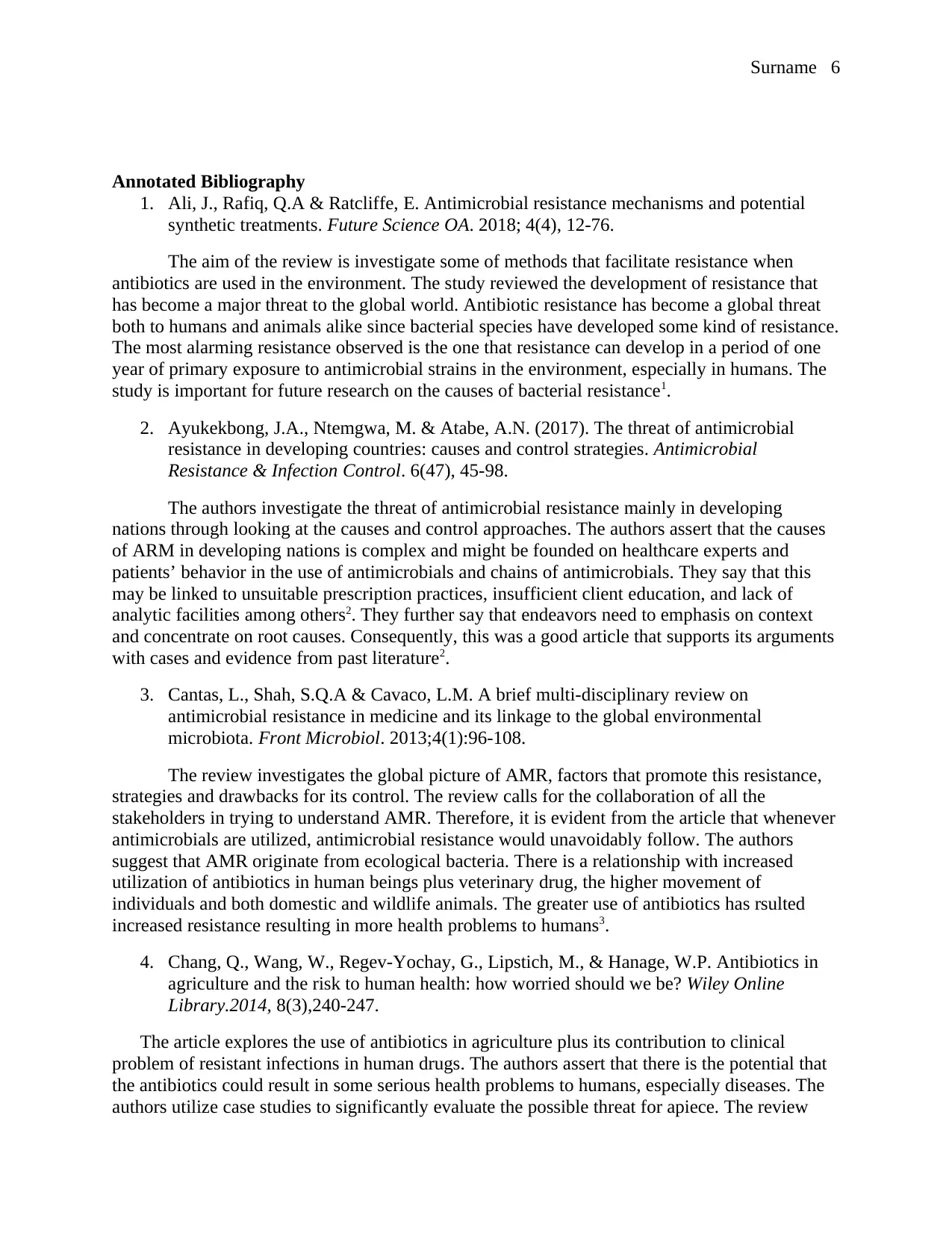
Surname 6
Annotated Bibliography
1. Ali, J., Rafiq, Q.A & Ratcliffe, E. Antimicrobial resistance mechanisms and potential
synthetic treatments. Future Science OA. 2018; 4(4), 12-76.
The aim of the review is investigate some of methods that facilitate resistance when
antibiotics are used in the environment. The study reviewed the development of resistance that
has become a major threat to the global world. Antibiotic resistance has become a global threat
both to humans and animals alike since bacterial species have developed some kind of resistance.
The most alarming resistance observed is the one that resistance can develop in a period of one
year of primary exposure to antimicrobial strains in the environment, especially in humans. The
study is important for future research on the causes of bacterial resistance1.
2. Ayukekbong, J.A., Ntemgwa, M. & Atabe, A.N. (2017). The threat of antimicrobial
resistance in developing countries: causes and control strategies. Antimicrobial
Resistance & Infection Control. 6(47), 45-98.
The authors investigate the threat of antimicrobial resistance mainly in developing
nations through looking at the causes and control approaches. The authors assert that the causes
of ARM in developing nations is complex and might be founded on healthcare experts and
patients’ behavior in the use of antimicrobials and chains of antimicrobials. They say that this
may be linked to unsuitable prescription practices, insufficient client education, and lack of
analytic facilities among others2. They further say that endeavors need to emphasis on context
and concentrate on root causes. Consequently, this was a good article that supports its arguments
with cases and evidence from past literature2.
3. Cantas, L., Shah, S.Q.A & Cavaco, L.M. A brief multi-disciplinary review on
antimicrobial resistance in medicine and its linkage to the global environmental
microbiota. Front Microbiol. 2013;4(1):96-108.
The review investigates the global picture of AMR, factors that promote this resistance,
strategies and drawbacks for its control. The review calls for the collaboration of all the
stakeholders in trying to understand AMR. Therefore, it is evident from the article that whenever
antimicrobials are utilized, antimicrobial resistance would unavoidably follow. The authors
suggest that AMR originate from ecological bacteria. There is a relationship with increased
utilization of antibiotics in human beings plus veterinary drug, the higher movement of
individuals and both domestic and wildlife animals. The greater use of antibiotics has rsulted
increased resistance resulting in more health problems to humans3.
4. Chang, Q., Wang, W., Regev-Yochay, G., Lipstich, M., & Hanage, W.P. Antibiotics in
agriculture and the risk to human health: how worried should we be? Wiley Online
Library.2014, 8(3),240-247.
The article explores the use of antibiotics in agriculture plus its contribution to clinical
problem of resistant infections in human drugs. The authors assert that there is the potential that
the antibiotics could result in some serious health problems to humans, especially diseases. The
authors utilize case studies to significantly evaluate the possible threat for apiece. The review
Annotated Bibliography
1. Ali, J., Rafiq, Q.A & Ratcliffe, E. Antimicrobial resistance mechanisms and potential
synthetic treatments. Future Science OA. 2018; 4(4), 12-76.
The aim of the review is investigate some of methods that facilitate resistance when
antibiotics are used in the environment. The study reviewed the development of resistance that
has become a major threat to the global world. Antibiotic resistance has become a global threat
both to humans and animals alike since bacterial species have developed some kind of resistance.
The most alarming resistance observed is the one that resistance can develop in a period of one
year of primary exposure to antimicrobial strains in the environment, especially in humans. The
study is important for future research on the causes of bacterial resistance1.
2. Ayukekbong, J.A., Ntemgwa, M. & Atabe, A.N. (2017). The threat of antimicrobial
resistance in developing countries: causes and control strategies. Antimicrobial
Resistance & Infection Control. 6(47), 45-98.
The authors investigate the threat of antimicrobial resistance mainly in developing
nations through looking at the causes and control approaches. The authors assert that the causes
of ARM in developing nations is complex and might be founded on healthcare experts and
patients’ behavior in the use of antimicrobials and chains of antimicrobials. They say that this
may be linked to unsuitable prescription practices, insufficient client education, and lack of
analytic facilities among others2. They further say that endeavors need to emphasis on context
and concentrate on root causes. Consequently, this was a good article that supports its arguments
with cases and evidence from past literature2.
3. Cantas, L., Shah, S.Q.A & Cavaco, L.M. A brief multi-disciplinary review on
antimicrobial resistance in medicine and its linkage to the global environmental
microbiota. Front Microbiol. 2013;4(1):96-108.
The review investigates the global picture of AMR, factors that promote this resistance,
strategies and drawbacks for its control. The review calls for the collaboration of all the
stakeholders in trying to understand AMR. Therefore, it is evident from the article that whenever
antimicrobials are utilized, antimicrobial resistance would unavoidably follow. The authors
suggest that AMR originate from ecological bacteria. There is a relationship with increased
utilization of antibiotics in human beings plus veterinary drug, the higher movement of
individuals and both domestic and wildlife animals. The greater use of antibiotics has rsulted
increased resistance resulting in more health problems to humans3.
4. Chang, Q., Wang, W., Regev-Yochay, G., Lipstich, M., & Hanage, W.P. Antibiotics in
agriculture and the risk to human health: how worried should we be? Wiley Online
Library.2014, 8(3),240-247.
The article explores the use of antibiotics in agriculture plus its contribution to clinical
problem of resistant infections in human drugs. The authors assert that there is the potential that
the antibiotics could result in some serious health problems to humans, especially diseases. The
authors utilize case studies to significantly evaluate the possible threat for apiece. The review
⊘ This is a preview!⊘
Do you want full access?
Subscribe today to unlock all pages.

Trusted by 1+ million students worldwide
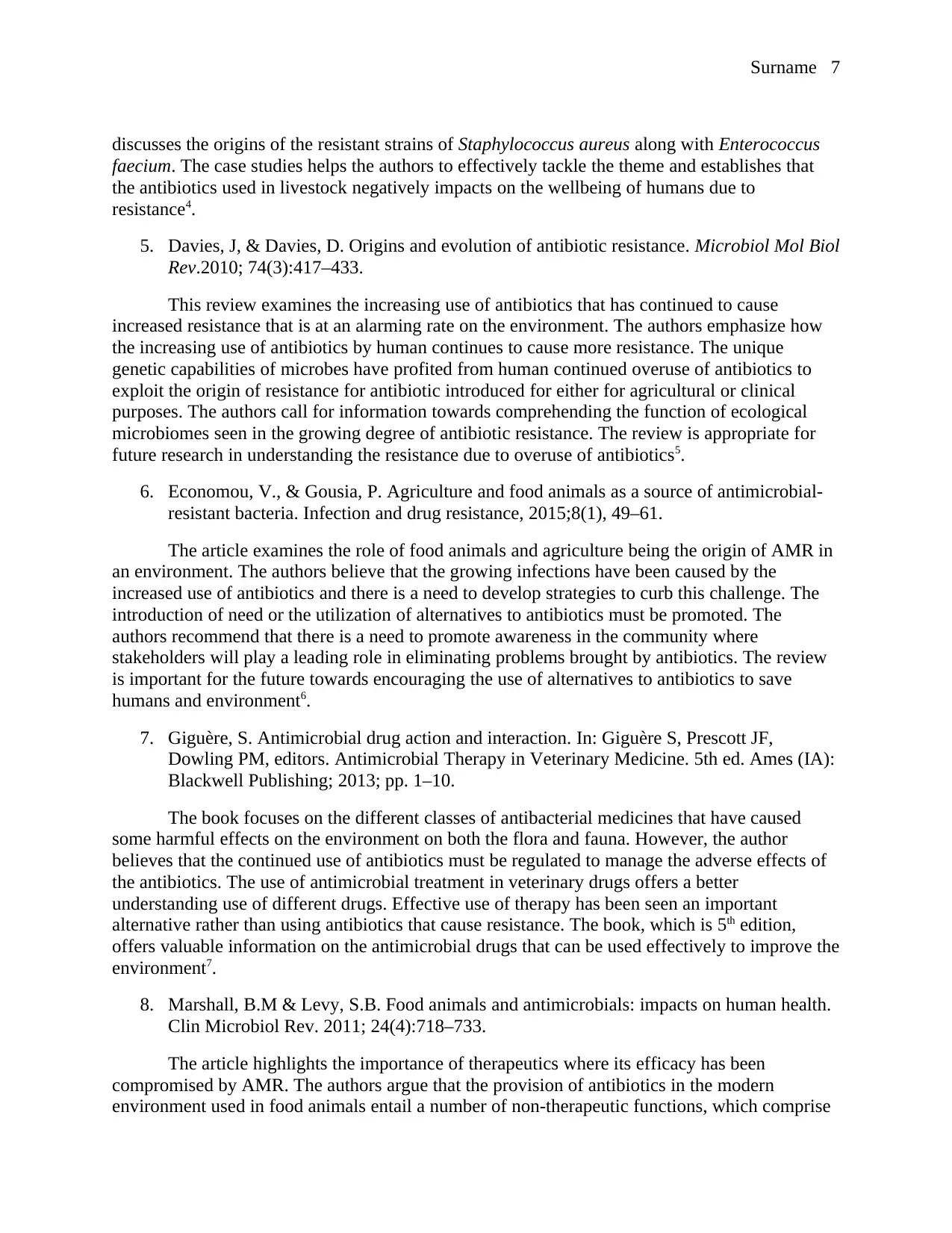
Surname 7
discusses the origins of the resistant strains of Staphylococcus aureus along with Enterococcus
faecium. The case studies helps the authors to effectively tackle the theme and establishes that
the antibiotics used in livestock negatively impacts on the wellbeing of humans due to
resistance4.
5. Davies, J, & Davies, D. Origins and evolution of antibiotic resistance. Microbiol Mol Biol
Rev.2010; 74(3):417–433.
This review examines the increasing use of antibiotics that has continued to cause
increased resistance that is at an alarming rate on the environment. The authors emphasize how
the increasing use of antibiotics by human continues to cause more resistance. The unique
genetic capabilities of microbes have profited from human continued overuse of antibiotics to
exploit the origin of resistance for antibiotic introduced for either for agricultural or clinical
purposes. The authors call for information towards comprehending the function of ecological
microbiomes seen in the growing degree of antibiotic resistance. The review is appropriate for
future research in understanding the resistance due to overuse of antibiotics5.
6. Economou, V., & Gousia, P. Agriculture and food animals as a source of antimicrobial-
resistant bacteria. Infection and drug resistance, 2015;8(1), 49–61.
The article examines the role of food animals and agriculture being the origin of AMR in
an environment. The authors believe that the growing infections have been caused by the
increased use of antibiotics and there is a need to develop strategies to curb this challenge. The
introduction of need or the utilization of alternatives to antibiotics must be promoted. The
authors recommend that there is a need to promote awareness in the community where
stakeholders will play a leading role in eliminating problems brought by antibiotics. The review
is important for the future towards encouraging the use of alternatives to antibiotics to save
humans and environment6.
7. Giguère, S. Antimicrobial drug action and interaction. In: Giguère S, Prescott JF,
Dowling PM, editors. Antimicrobial Therapy in Veterinary Medicine. 5th ed. Ames (IA):
Blackwell Publishing; 2013; pp. 1–10.
The book focuses on the different classes of antibacterial medicines that have caused
some harmful effects on the environment on both the flora and fauna. However, the author
believes that the continued use of antibiotics must be regulated to manage the adverse effects of
the antibiotics. The use of antimicrobial treatment in veterinary drugs offers a better
understanding use of different drugs. Effective use of therapy has been seen an important
alternative rather than using antibiotics that cause resistance. The book, which is 5th edition,
offers valuable information on the antimicrobial drugs that can be used effectively to improve the
environment7.
8. Marshall, B.M & Levy, S.B. Food animals and antimicrobials: impacts on human health.
Clin Microbiol Rev. 2011; 24(4):718–733.
The article highlights the importance of therapeutics where its efficacy has been
compromised by AMR. The authors argue that the provision of antibiotics in the modern
environment used in food animals entail a number of non-therapeutic functions, which comprise
discusses the origins of the resistant strains of Staphylococcus aureus along with Enterococcus
faecium. The case studies helps the authors to effectively tackle the theme and establishes that
the antibiotics used in livestock negatively impacts on the wellbeing of humans due to
resistance4.
5. Davies, J, & Davies, D. Origins and evolution of antibiotic resistance. Microbiol Mol Biol
Rev.2010; 74(3):417–433.
This review examines the increasing use of antibiotics that has continued to cause
increased resistance that is at an alarming rate on the environment. The authors emphasize how
the increasing use of antibiotics by human continues to cause more resistance. The unique
genetic capabilities of microbes have profited from human continued overuse of antibiotics to
exploit the origin of resistance for antibiotic introduced for either for agricultural or clinical
purposes. The authors call for information towards comprehending the function of ecological
microbiomes seen in the growing degree of antibiotic resistance. The review is appropriate for
future research in understanding the resistance due to overuse of antibiotics5.
6. Economou, V., & Gousia, P. Agriculture and food animals as a source of antimicrobial-
resistant bacteria. Infection and drug resistance, 2015;8(1), 49–61.
The article examines the role of food animals and agriculture being the origin of AMR in
an environment. The authors believe that the growing infections have been caused by the
increased use of antibiotics and there is a need to develop strategies to curb this challenge. The
introduction of need or the utilization of alternatives to antibiotics must be promoted. The
authors recommend that there is a need to promote awareness in the community where
stakeholders will play a leading role in eliminating problems brought by antibiotics. The review
is important for the future towards encouraging the use of alternatives to antibiotics to save
humans and environment6.
7. Giguère, S. Antimicrobial drug action and interaction. In: Giguère S, Prescott JF,
Dowling PM, editors. Antimicrobial Therapy in Veterinary Medicine. 5th ed. Ames (IA):
Blackwell Publishing; 2013; pp. 1–10.
The book focuses on the different classes of antibacterial medicines that have caused
some harmful effects on the environment on both the flora and fauna. However, the author
believes that the continued use of antibiotics must be regulated to manage the adverse effects of
the antibiotics. The use of antimicrobial treatment in veterinary drugs offers a better
understanding use of different drugs. Effective use of therapy has been seen an important
alternative rather than using antibiotics that cause resistance. The book, which is 5th edition,
offers valuable information on the antimicrobial drugs that can be used effectively to improve the
environment7.
8. Marshall, B.M & Levy, S.B. Food animals and antimicrobials: impacts on human health.
Clin Microbiol Rev. 2011; 24(4):718–733.
The article highlights the importance of therapeutics where its efficacy has been
compromised by AMR. The authors argue that the provision of antibiotics in the modern
environment used in food animals entail a number of non-therapeutic functions, which comprise
Paraphrase This Document
Need a fresh take? Get an instant paraphrase of this document with our AI Paraphraser
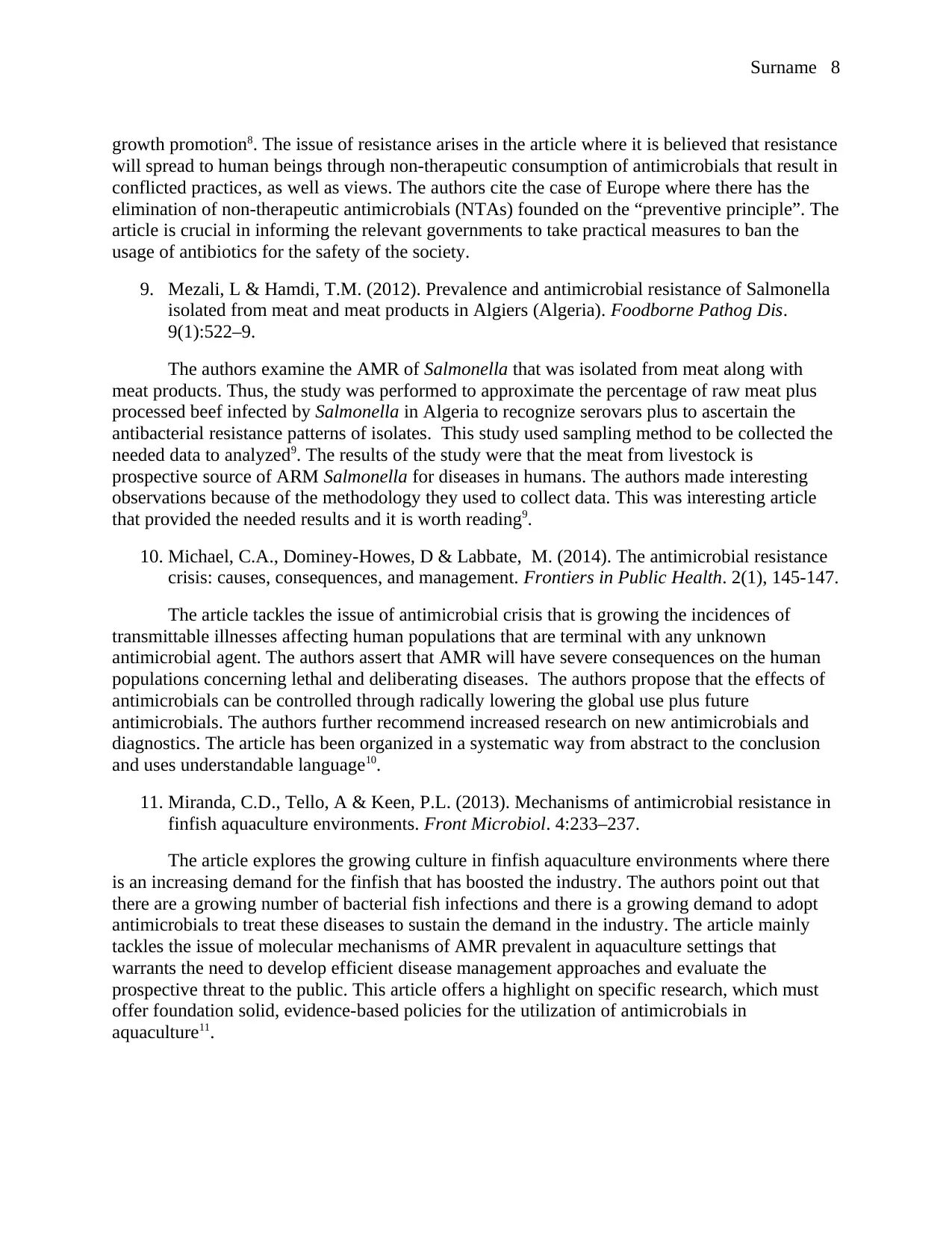
Surname 8
growth promotion8. The issue of resistance arises in the article where it is believed that resistance
will spread to human beings through non-therapeutic consumption of antimicrobials that result in
conflicted practices, as well as views. The authors cite the case of Europe where there has the
elimination of non-therapeutic antimicrobials (NTAs) founded on the “preventive principle”. The
article is crucial in informing the relevant governments to take practical measures to ban the
usage of antibiotics for the safety of the society.
9. Mezali, L & Hamdi, T.M. (2012). Prevalence and antimicrobial resistance of Salmonella
isolated from meat and meat products in Algiers (Algeria). Foodborne Pathog Dis.
9(1):522–9.
The authors examine the AMR of Salmonella that was isolated from meat along with
meat products. Thus, the study was performed to approximate the percentage of raw meat plus
processed beef infected by Salmonella in Algeria to recognize serovars plus to ascertain the
antibacterial resistance patterns of isolates. This study used sampling method to be collected the
needed data to analyzed9. The results of the study were that the meat from livestock is
prospective source of ARM Salmonella for diseases in humans. The authors made interesting
observations because of the methodology they used to collect data. This was interesting article
that provided the needed results and it is worth reading9.
10. Michael, C.A., Dominey-Howes, D & Labbate, M. (2014). The antimicrobial resistance
crisis: causes, consequences, and management. Frontiers in Public Health. 2(1), 145-147.
The article tackles the issue of antimicrobial crisis that is growing the incidences of
transmittable illnesses affecting human populations that are terminal with any unknown
antimicrobial agent. The authors assert that AMR will have severe consequences on the human
populations concerning lethal and deliberating diseases. The authors propose that the effects of
antimicrobials can be controlled through radically lowering the global use plus future
antimicrobials. The authors further recommend increased research on new antimicrobials and
diagnostics. The article has been organized in a systematic way from abstract to the conclusion
and uses understandable language10.
11. Miranda, C.D., Tello, A & Keen, P.L. (2013). Mechanisms of antimicrobial resistance in
finfish aquaculture environments. Front Microbiol. 4:233–237.
The article explores the growing culture in finfish aquaculture environments where there
is an increasing demand for the finfish that has boosted the industry. The authors point out that
there are a growing number of bacterial fish infections and there is a growing demand to adopt
antimicrobials to treat these diseases to sustain the demand in the industry. The article mainly
tackles the issue of molecular mechanisms of AMR prevalent in aquaculture settings that
warrants the need to develop efficient disease management approaches and evaluate the
prospective threat to the public. This article offers a highlight on specific research, which must
offer foundation solid, evidence-based policies for the utilization of antimicrobials in
aquaculture11.
growth promotion8. The issue of resistance arises in the article where it is believed that resistance
will spread to human beings through non-therapeutic consumption of antimicrobials that result in
conflicted practices, as well as views. The authors cite the case of Europe where there has the
elimination of non-therapeutic antimicrobials (NTAs) founded on the “preventive principle”. The
article is crucial in informing the relevant governments to take practical measures to ban the
usage of antibiotics for the safety of the society.
9. Mezali, L & Hamdi, T.M. (2012). Prevalence and antimicrobial resistance of Salmonella
isolated from meat and meat products in Algiers (Algeria). Foodborne Pathog Dis.
9(1):522–9.
The authors examine the AMR of Salmonella that was isolated from meat along with
meat products. Thus, the study was performed to approximate the percentage of raw meat plus
processed beef infected by Salmonella in Algeria to recognize serovars plus to ascertain the
antibacterial resistance patterns of isolates. This study used sampling method to be collected the
needed data to analyzed9. The results of the study were that the meat from livestock is
prospective source of ARM Salmonella for diseases in humans. The authors made interesting
observations because of the methodology they used to collect data. This was interesting article
that provided the needed results and it is worth reading9.
10. Michael, C.A., Dominey-Howes, D & Labbate, M. (2014). The antimicrobial resistance
crisis: causes, consequences, and management. Frontiers in Public Health. 2(1), 145-147.
The article tackles the issue of antimicrobial crisis that is growing the incidences of
transmittable illnesses affecting human populations that are terminal with any unknown
antimicrobial agent. The authors assert that AMR will have severe consequences on the human
populations concerning lethal and deliberating diseases. The authors propose that the effects of
antimicrobials can be controlled through radically lowering the global use plus future
antimicrobials. The authors further recommend increased research on new antimicrobials and
diagnostics. The article has been organized in a systematic way from abstract to the conclusion
and uses understandable language10.
11. Miranda, C.D., Tello, A & Keen, P.L. (2013). Mechanisms of antimicrobial resistance in
finfish aquaculture environments. Front Microbiol. 4:233–237.
The article explores the growing culture in finfish aquaculture environments where there
is an increasing demand for the finfish that has boosted the industry. The authors point out that
there are a growing number of bacterial fish infections and there is a growing demand to adopt
antimicrobials to treat these diseases to sustain the demand in the industry. The article mainly
tackles the issue of molecular mechanisms of AMR prevalent in aquaculture settings that
warrants the need to develop efficient disease management approaches and evaluate the
prospective threat to the public. This article offers a highlight on specific research, which must
offer foundation solid, evidence-based policies for the utilization of antimicrobials in
aquaculture11.
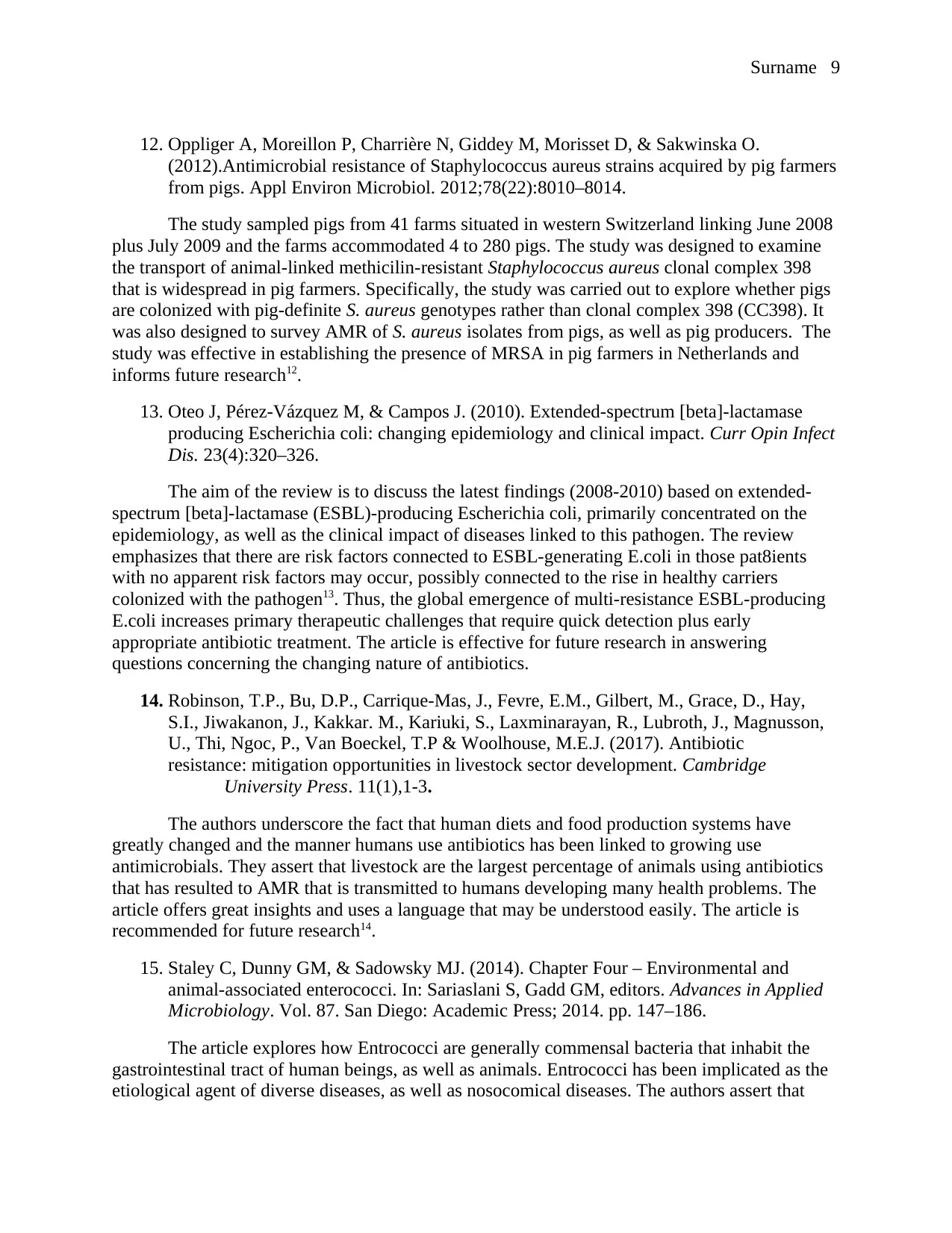
Surname 9
12. Oppliger A, Moreillon P, Charrière N, Giddey M, Morisset D, & Sakwinska O.
(2012).Antimicrobial resistance of Staphylococcus aureus strains acquired by pig farmers
from pigs. Appl Environ Microbiol. 2012;78(22):8010–8014.
The study sampled pigs from 41 farms situated in western Switzerland linking June 2008
plus July 2009 and the farms accommodated 4 to 280 pigs. The study was designed to examine
the transport of animal-linked methicilin-resistant Staphylococcus aureus clonal complex 398
that is widespread in pig farmers. Specifically, the study was carried out to explore whether pigs
are colonized with pig-definite S. aureus genotypes rather than clonal complex 398 (CC398). It
was also designed to survey AMR of S. aureus isolates from pigs, as well as pig producers. The
study was effective in establishing the presence of MRSA in pig farmers in Netherlands and
informs future research12.
13. Oteo J, Pérez-Vázquez M, & Campos J. (2010). Extended-spectrum [beta]-lactamase
producing Escherichia coli: changing epidemiology and clinical impact. Curr Opin Infect
Dis. 23(4):320–326.
The aim of the review is to discuss the latest findings (2008-2010) based on extended-
spectrum [beta]-lactamase (ESBL)-producing Escherichia coli, primarily concentrated on the
epidemiology, as well as the clinical impact of diseases linked to this pathogen. The review
emphasizes that there are risk factors connected to ESBL-generating E.coli in those pat8ients
with no apparent risk factors may occur, possibly connected to the rise in healthy carriers
colonized with the pathogen13. Thus, the global emergence of multi-resistance ESBL-producing
E.coli increases primary therapeutic challenges that require quick detection plus early
appropriate antibiotic treatment. The article is effective for future research in answering
questions concerning the changing nature of antibiotics.
14. Robinson, T.P., Bu, D.P., Carrique-Mas, J., Fevre, E.M., Gilbert, M., Grace, D., Hay,
S.I., Jiwakanon, J., Kakkar. M., Kariuki, S., Laxminarayan, R., Lubroth, J., Magnusson,
U., Thi, Ngoc, P., Van Boeckel, T.P & Woolhouse, M.E.J. (2017). Antibiotic
resistance: mitigation opportunities in livestock sector development. Cambridge
University Press. 11(1),1-3.
The authors underscore the fact that human diets and food production systems have
greatly changed and the manner humans use antibiotics has been linked to growing use
antimicrobials. They assert that livestock are the largest percentage of animals using antibiotics
that has resulted to AMR that is transmitted to humans developing many health problems. The
article offers great insights and uses a language that may be understood easily. The article is
recommended for future research14.
15. Staley C, Dunny GM, & Sadowsky MJ. (2014). Chapter Four – Environmental and
animal-associated enterococci. In: Sariaslani S, Gadd GM, editors. Advances in Applied
Microbiology. Vol. 87. San Diego: Academic Press; 2014. pp. 147–186.
The article explores how Entrococci are generally commensal bacteria that inhabit the
gastrointestinal tract of human beings, as well as animals. Entrococci has been implicated as the
etiological agent of diverse diseases, as well as nosocomical diseases. The authors assert that
12. Oppliger A, Moreillon P, Charrière N, Giddey M, Morisset D, & Sakwinska O.
(2012).Antimicrobial resistance of Staphylococcus aureus strains acquired by pig farmers
from pigs. Appl Environ Microbiol. 2012;78(22):8010–8014.
The study sampled pigs from 41 farms situated in western Switzerland linking June 2008
plus July 2009 and the farms accommodated 4 to 280 pigs. The study was designed to examine
the transport of animal-linked methicilin-resistant Staphylococcus aureus clonal complex 398
that is widespread in pig farmers. Specifically, the study was carried out to explore whether pigs
are colonized with pig-definite S. aureus genotypes rather than clonal complex 398 (CC398). It
was also designed to survey AMR of S. aureus isolates from pigs, as well as pig producers. The
study was effective in establishing the presence of MRSA in pig farmers in Netherlands and
informs future research12.
13. Oteo J, Pérez-Vázquez M, & Campos J. (2010). Extended-spectrum [beta]-lactamase
producing Escherichia coli: changing epidemiology and clinical impact. Curr Opin Infect
Dis. 23(4):320–326.
The aim of the review is to discuss the latest findings (2008-2010) based on extended-
spectrum [beta]-lactamase (ESBL)-producing Escherichia coli, primarily concentrated on the
epidemiology, as well as the clinical impact of diseases linked to this pathogen. The review
emphasizes that there are risk factors connected to ESBL-generating E.coli in those pat8ients
with no apparent risk factors may occur, possibly connected to the rise in healthy carriers
colonized with the pathogen13. Thus, the global emergence of multi-resistance ESBL-producing
E.coli increases primary therapeutic challenges that require quick detection plus early
appropriate antibiotic treatment. The article is effective for future research in answering
questions concerning the changing nature of antibiotics.
14. Robinson, T.P., Bu, D.P., Carrique-Mas, J., Fevre, E.M., Gilbert, M., Grace, D., Hay,
S.I., Jiwakanon, J., Kakkar. M., Kariuki, S., Laxminarayan, R., Lubroth, J., Magnusson,
U., Thi, Ngoc, P., Van Boeckel, T.P & Woolhouse, M.E.J. (2017). Antibiotic
resistance: mitigation opportunities in livestock sector development. Cambridge
University Press. 11(1),1-3.
The authors underscore the fact that human diets and food production systems have
greatly changed and the manner humans use antibiotics has been linked to growing use
antimicrobials. They assert that livestock are the largest percentage of animals using antibiotics
that has resulted to AMR that is transmitted to humans developing many health problems. The
article offers great insights and uses a language that may be understood easily. The article is
recommended for future research14.
15. Staley C, Dunny GM, & Sadowsky MJ. (2014). Chapter Four – Environmental and
animal-associated enterococci. In: Sariaslani S, Gadd GM, editors. Advances in Applied
Microbiology. Vol. 87. San Diego: Academic Press; 2014. pp. 147–186.
The article explores how Entrococci are generally commensal bacteria that inhabit the
gastrointestinal tract of human beings, as well as animals. Entrococci has been implicated as the
etiological agent of diverse diseases, as well as nosocomical diseases. The authors assert that
⊘ This is a preview!⊘
Do you want full access?
Subscribe today to unlock all pages.

Trusted by 1+ million students worldwide
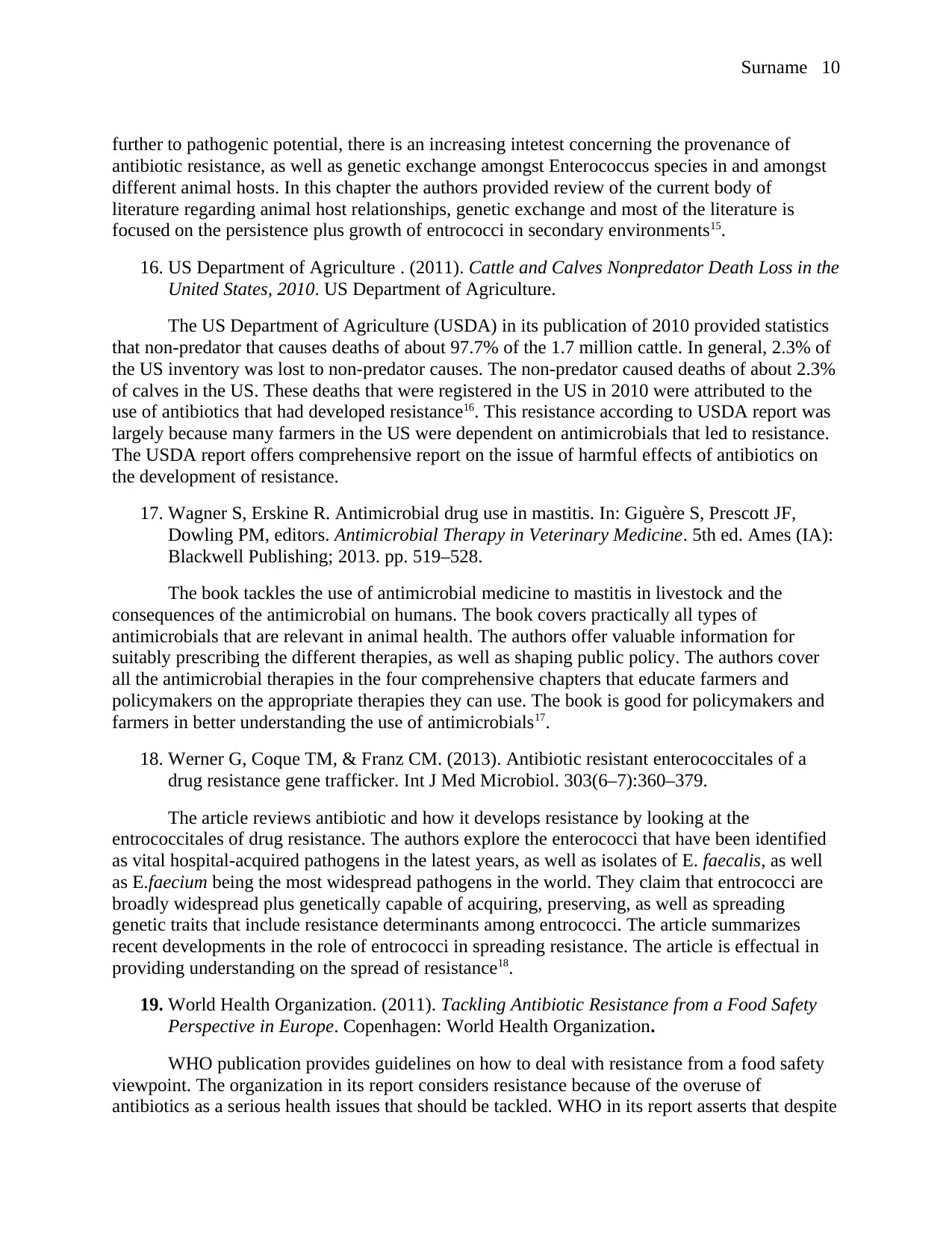
Surname 10
further to pathogenic potential, there is an increasing intetest concerning the provenance of
antibiotic resistance, as well as genetic exchange amongst Enterococcus species in and amongst
different animal hosts. In this chapter the authors provided review of the current body of
literature regarding animal host relationships, genetic exchange and most of the literature is
focused on the persistence plus growth of entrococci in secondary environments15.
16. US Department of Agriculture . (2011). Cattle and Calves Nonpredator Death Loss in the
United States, 2010. US Department of Agriculture.
The US Department of Agriculture (USDA) in its publication of 2010 provided statistics
that non-predator that causes deaths of about 97.7% of the 1.7 million cattle. In general, 2.3% of
the US inventory was lost to non-predator causes. The non-predator caused deaths of about 2.3%
of calves in the US. These deaths that were registered in the US in 2010 were attributed to the
use of antibiotics that had developed resistance16. This resistance according to USDA report was
largely because many farmers in the US were dependent on antimicrobials that led to resistance.
The USDA report offers comprehensive report on the issue of harmful effects of antibiotics on
the development of resistance.
17. Wagner S, Erskine R. Antimicrobial drug use in mastitis. In: Giguère S, Prescott JF,
Dowling PM, editors. Antimicrobial Therapy in Veterinary Medicine. 5th ed. Ames (IA):
Blackwell Publishing; 2013. pp. 519–528.
The book tackles the use of antimicrobial medicine to mastitis in livestock and the
consequences of the antimicrobial on humans. The book covers practically all types of
antimicrobials that are relevant in animal health. The authors offer valuable information for
suitably prescribing the different therapies, as well as shaping public policy. The authors cover
all the antimicrobial therapies in the four comprehensive chapters that educate farmers and
policymakers on the appropriate therapies they can use. The book is good for policymakers and
farmers in better understanding the use of antimicrobials17.
18. Werner G, Coque TM, & Franz CM. (2013). Antibiotic resistant enterococcitales of a
drug resistance gene trafficker. Int J Med Microbiol. 303(6–7):360–379.
The article reviews antibiotic and how it develops resistance by looking at the
entrococcitales of drug resistance. The authors explore the enterococci that have been identified
as vital hospital-acquired pathogens in the latest years, as well as isolates of E. faecalis, as well
as E.faecium being the most widespread pathogens in the world. They claim that entrococci are
broadly widespread plus genetically capable of acquiring, preserving, as well as spreading
genetic traits that include resistance determinants among entrococci. The article summarizes
recent developments in the role of entrococci in spreading resistance. The article is effectual in
providing understanding on the spread of resistance18.
19. World Health Organization. (2011). Tackling Antibiotic Resistance from a Food Safety
Perspective in Europe. Copenhagen: World Health Organization.
WHO publication provides guidelines on how to deal with resistance from a food safety
viewpoint. The organization in its report considers resistance because of the overuse of
antibiotics as a serious health issues that should be tackled. WHO in its report asserts that despite
further to pathogenic potential, there is an increasing intetest concerning the provenance of
antibiotic resistance, as well as genetic exchange amongst Enterococcus species in and amongst
different animal hosts. In this chapter the authors provided review of the current body of
literature regarding animal host relationships, genetic exchange and most of the literature is
focused on the persistence plus growth of entrococci in secondary environments15.
16. US Department of Agriculture . (2011). Cattle and Calves Nonpredator Death Loss in the
United States, 2010. US Department of Agriculture.
The US Department of Agriculture (USDA) in its publication of 2010 provided statistics
that non-predator that causes deaths of about 97.7% of the 1.7 million cattle. In general, 2.3% of
the US inventory was lost to non-predator causes. The non-predator caused deaths of about 2.3%
of calves in the US. These deaths that were registered in the US in 2010 were attributed to the
use of antibiotics that had developed resistance16. This resistance according to USDA report was
largely because many farmers in the US were dependent on antimicrobials that led to resistance.
The USDA report offers comprehensive report on the issue of harmful effects of antibiotics on
the development of resistance.
17. Wagner S, Erskine R. Antimicrobial drug use in mastitis. In: Giguère S, Prescott JF,
Dowling PM, editors. Antimicrobial Therapy in Veterinary Medicine. 5th ed. Ames (IA):
Blackwell Publishing; 2013. pp. 519–528.
The book tackles the use of antimicrobial medicine to mastitis in livestock and the
consequences of the antimicrobial on humans. The book covers practically all types of
antimicrobials that are relevant in animal health. The authors offer valuable information for
suitably prescribing the different therapies, as well as shaping public policy. The authors cover
all the antimicrobial therapies in the four comprehensive chapters that educate farmers and
policymakers on the appropriate therapies they can use. The book is good for policymakers and
farmers in better understanding the use of antimicrobials17.
18. Werner G, Coque TM, & Franz CM. (2013). Antibiotic resistant enterococcitales of a
drug resistance gene trafficker. Int J Med Microbiol. 303(6–7):360–379.
The article reviews antibiotic and how it develops resistance by looking at the
entrococcitales of drug resistance. The authors explore the enterococci that have been identified
as vital hospital-acquired pathogens in the latest years, as well as isolates of E. faecalis, as well
as E.faecium being the most widespread pathogens in the world. They claim that entrococci are
broadly widespread plus genetically capable of acquiring, preserving, as well as spreading
genetic traits that include resistance determinants among entrococci. The article summarizes
recent developments in the role of entrococci in spreading resistance. The article is effectual in
providing understanding on the spread of resistance18.
19. World Health Organization. (2011). Tackling Antibiotic Resistance from a Food Safety
Perspective in Europe. Copenhagen: World Health Organization.
WHO publication provides guidelines on how to deal with resistance from a food safety
viewpoint. The organization in its report considers resistance because of the overuse of
antibiotics as a serious health issues that should be tackled. WHO in its report asserts that despite
Paraphrase This Document
Need a fresh take? Get an instant paraphrase of this document with our AI Paraphraser
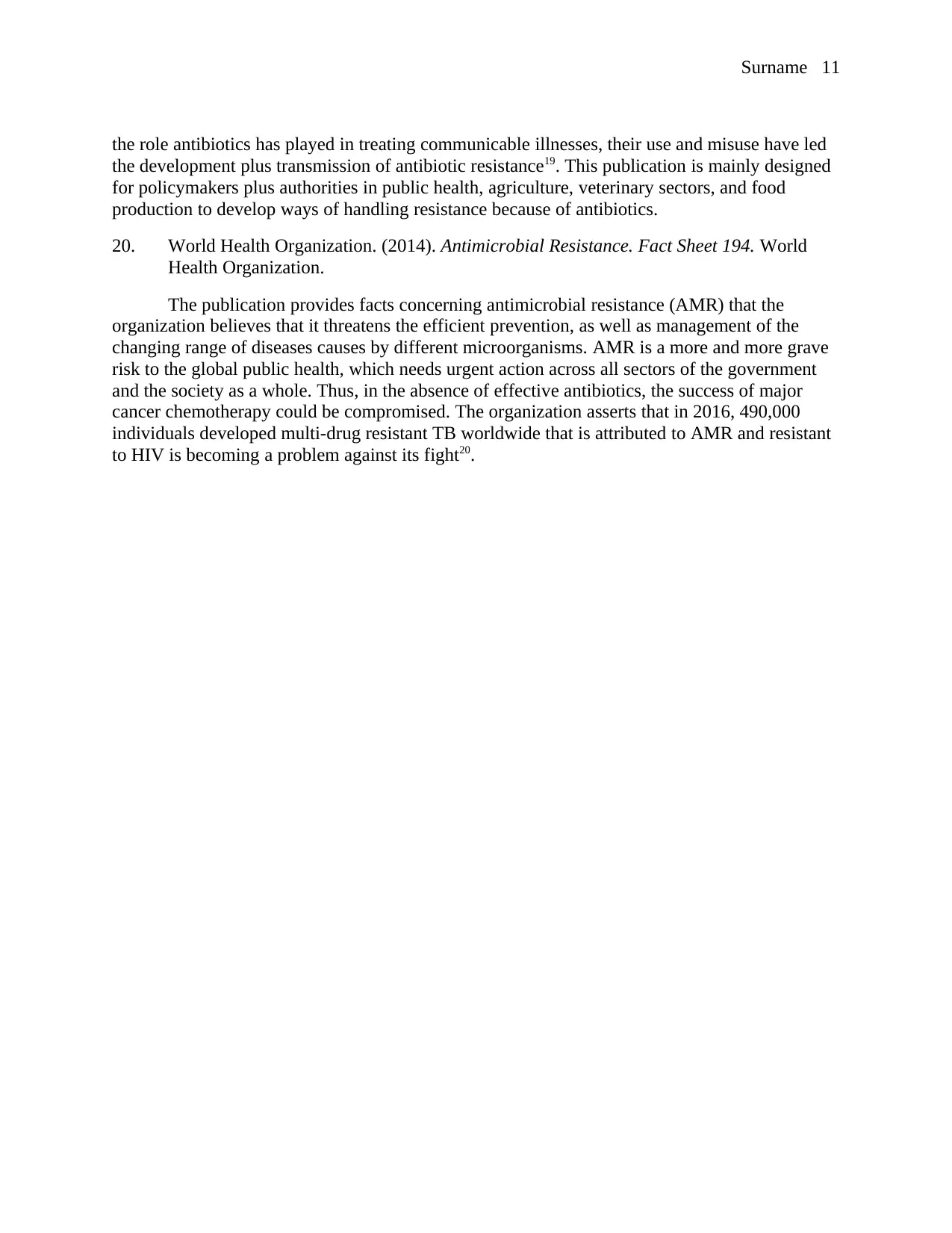
Surname 11
the role antibiotics has played in treating communicable illnesses, their use and misuse have led
the development plus transmission of antibiotic resistance19. This publication is mainly designed
for policymakers plus authorities in public health, agriculture, veterinary sectors, and food
production to develop ways of handling resistance because of antibiotics.
20. World Health Organization. (2014). Antimicrobial Resistance. Fact Sheet 194. World
Health Organization.
The publication provides facts concerning antimicrobial resistance (AMR) that the
organization believes that it threatens the efficient prevention, as well as management of the
changing range of diseases causes by different microorganisms. AMR is a more and more grave
risk to the global public health, which needs urgent action across all sectors of the government
and the society as a whole. Thus, in the absence of effective antibiotics, the success of major
cancer chemotherapy could be compromised. The organization asserts that in 2016, 490,000
individuals developed multi-drug resistant TB worldwide that is attributed to AMR and resistant
to HIV is becoming a problem against its fight20.
the role antibiotics has played in treating communicable illnesses, their use and misuse have led
the development plus transmission of antibiotic resistance19. This publication is mainly designed
for policymakers plus authorities in public health, agriculture, veterinary sectors, and food
production to develop ways of handling resistance because of antibiotics.
20. World Health Organization. (2014). Antimicrobial Resistance. Fact Sheet 194. World
Health Organization.
The publication provides facts concerning antimicrobial resistance (AMR) that the
organization believes that it threatens the efficient prevention, as well as management of the
changing range of diseases causes by different microorganisms. AMR is a more and more grave
risk to the global public health, which needs urgent action across all sectors of the government
and the society as a whole. Thus, in the absence of effective antibiotics, the success of major
cancer chemotherapy could be compromised. The organization asserts that in 2016, 490,000
individuals developed multi-drug resistant TB worldwide that is attributed to AMR and resistant
to HIV is becoming a problem against its fight20.
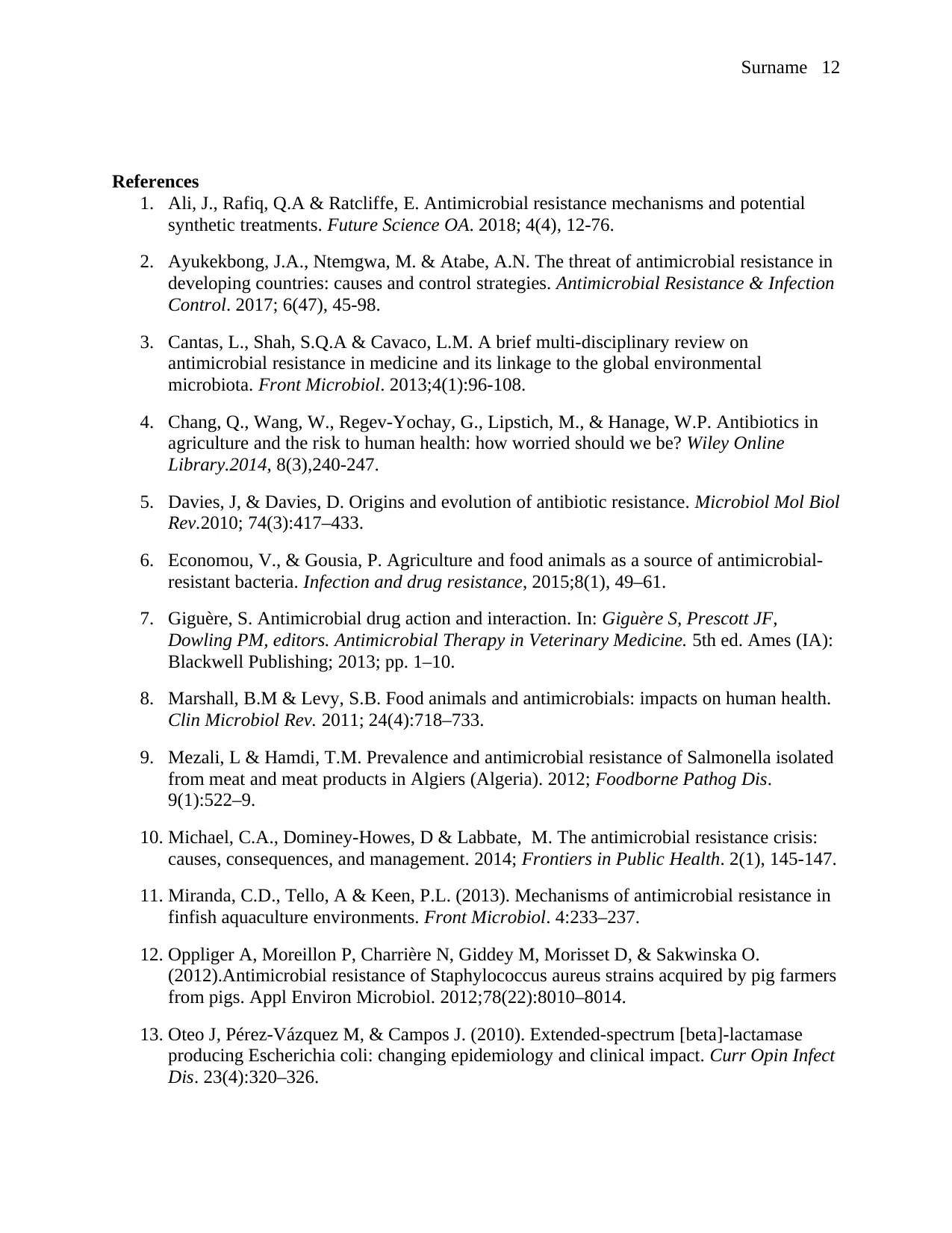
Surname 12
References
1. Ali, J., Rafiq, Q.A & Ratcliffe, E. Antimicrobial resistance mechanisms and potential
synthetic treatments. Future Science OA. 2018; 4(4), 12-76.
2. Ayukekbong, J.A., Ntemgwa, M. & Atabe, A.N. The threat of antimicrobial resistance in
developing countries: causes and control strategies. Antimicrobial Resistance & Infection
Control. 2017; 6(47), 45-98.
3. Cantas, L., Shah, S.Q.A & Cavaco, L.M. A brief multi-disciplinary review on
antimicrobial resistance in medicine and its linkage to the global environmental
microbiota. Front Microbiol. 2013;4(1):96-108.
4. Chang, Q., Wang, W., Regev-Yochay, G., Lipstich, M., & Hanage, W.P. Antibiotics in
agriculture and the risk to human health: how worried should we be? Wiley Online
Library.2014, 8(3),240-247.
5. Davies, J, & Davies, D. Origins and evolution of antibiotic resistance. Microbiol Mol Biol
Rev.2010; 74(3):417–433.
6. Economou, V., & Gousia, P. Agriculture and food animals as a source of antimicrobial-
resistant bacteria. Infection and drug resistance, 2015;8(1), 49–61.
7. Giguère, S. Antimicrobial drug action and interaction. In: Giguère S, Prescott JF,
Dowling PM, editors. Antimicrobial Therapy in Veterinary Medicine. 5th ed. Ames (IA):
Blackwell Publishing; 2013; pp. 1–10.
8. Marshall, B.M & Levy, S.B. Food animals and antimicrobials: impacts on human health.
Clin Microbiol Rev. 2011; 24(4):718–733.
9. Mezali, L & Hamdi, T.M. Prevalence and antimicrobial resistance of Salmonella isolated
from meat and meat products in Algiers (Algeria). 2012; Foodborne Pathog Dis.
9(1):522–9.
10. Michael, C.A., Dominey-Howes, D & Labbate, M. The antimicrobial resistance crisis:
causes, consequences, and management. 2014; Frontiers in Public Health. 2(1), 145-147.
11. Miranda, C.D., Tello, A & Keen, P.L. (2013). Mechanisms of antimicrobial resistance in
finfish aquaculture environments. Front Microbiol. 4:233–237.
12. Oppliger A, Moreillon P, Charrière N, Giddey M, Morisset D, & Sakwinska O.
(2012).Antimicrobial resistance of Staphylococcus aureus strains acquired by pig farmers
from pigs. Appl Environ Microbiol. 2012;78(22):8010–8014.
13. Oteo J, Pérez-Vázquez M, & Campos J. (2010). Extended-spectrum [beta]-lactamase
producing Escherichia coli: changing epidemiology and clinical impact. Curr Opin Infect
Dis. 23(4):320–326.
References
1. Ali, J., Rafiq, Q.A & Ratcliffe, E. Antimicrobial resistance mechanisms and potential
synthetic treatments. Future Science OA. 2018; 4(4), 12-76.
2. Ayukekbong, J.A., Ntemgwa, M. & Atabe, A.N. The threat of antimicrobial resistance in
developing countries: causes and control strategies. Antimicrobial Resistance & Infection
Control. 2017; 6(47), 45-98.
3. Cantas, L., Shah, S.Q.A & Cavaco, L.M. A brief multi-disciplinary review on
antimicrobial resistance in medicine and its linkage to the global environmental
microbiota. Front Microbiol. 2013;4(1):96-108.
4. Chang, Q., Wang, W., Regev-Yochay, G., Lipstich, M., & Hanage, W.P. Antibiotics in
agriculture and the risk to human health: how worried should we be? Wiley Online
Library.2014, 8(3),240-247.
5. Davies, J, & Davies, D. Origins and evolution of antibiotic resistance. Microbiol Mol Biol
Rev.2010; 74(3):417–433.
6. Economou, V., & Gousia, P. Agriculture and food animals as a source of antimicrobial-
resistant bacteria. Infection and drug resistance, 2015;8(1), 49–61.
7. Giguère, S. Antimicrobial drug action and interaction. In: Giguère S, Prescott JF,
Dowling PM, editors. Antimicrobial Therapy in Veterinary Medicine. 5th ed. Ames (IA):
Blackwell Publishing; 2013; pp. 1–10.
8. Marshall, B.M & Levy, S.B. Food animals and antimicrobials: impacts on human health.
Clin Microbiol Rev. 2011; 24(4):718–733.
9. Mezali, L & Hamdi, T.M. Prevalence and antimicrobial resistance of Salmonella isolated
from meat and meat products in Algiers (Algeria). 2012; Foodborne Pathog Dis.
9(1):522–9.
10. Michael, C.A., Dominey-Howes, D & Labbate, M. The antimicrobial resistance crisis:
causes, consequences, and management. 2014; Frontiers in Public Health. 2(1), 145-147.
11. Miranda, C.D., Tello, A & Keen, P.L. (2013). Mechanisms of antimicrobial resistance in
finfish aquaculture environments. Front Microbiol. 4:233–237.
12. Oppliger A, Moreillon P, Charrière N, Giddey M, Morisset D, & Sakwinska O.
(2012).Antimicrobial resistance of Staphylococcus aureus strains acquired by pig farmers
from pigs. Appl Environ Microbiol. 2012;78(22):8010–8014.
13. Oteo J, Pérez-Vázquez M, & Campos J. (2010). Extended-spectrum [beta]-lactamase
producing Escherichia coli: changing epidemiology and clinical impact. Curr Opin Infect
Dis. 23(4):320–326.
⊘ This is a preview!⊘
Do you want full access?
Subscribe today to unlock all pages.

Trusted by 1+ million students worldwide
1 out of 13
Your All-in-One AI-Powered Toolkit for Academic Success.
+13062052269
info@desklib.com
Available 24*7 on WhatsApp / Email
![[object Object]](/_next/static/media/star-bottom.7253800d.svg)
Unlock your academic potential
Copyright © 2020–2025 A2Z Services. All Rights Reserved. Developed and managed by ZUCOL.

